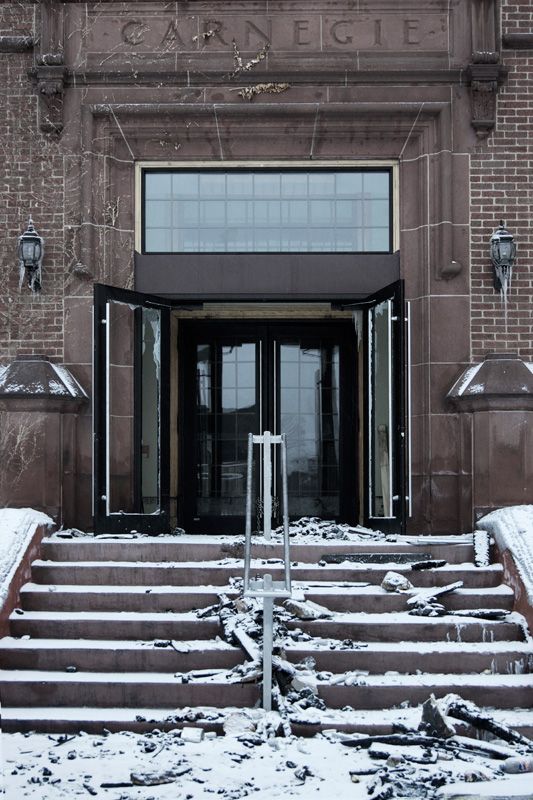This article was scraped from Rochester Subway. This is a blog about Rochester history and urbanism has not been published since 2017. The current owners are now publishing link spam which made me want to preserve this history.. The original article was published February 02, 2015 and can be found here.
![Last week, Carnegie Place was largely destroyed by fire. [PHOTO: PuddleJumper Photography]](https://senseofplace.dev/content/images/photos/rochester-carnegie-building-fire-01.jpg)
The following is a guest post submitted by Puddlejumper Photography .
Submit your story today .
Last week, Carnegie Place

was largely destroyed by fire. Its life spanned some of the most crucial and drastically changing times in Rochester's history. I had a chance to stop by after the fire and take some photographs of a building I have always enjoyed; in a part of town that was vibrant and still is the heart of the arts movement in Rochester...
![Last week, Carnegie Place was largely destroyed by fire. [PHOTO: PuddleJumper Photography]](https://senseofplace.dev/content/images/photos/rochester-carnegie-building-fire-02.jpg)
[Photos of the fire damage were taken by PuddleJumper Photography

. Historical photos are from the Albert R. Stone collection.]
I had heard of the fire a day before and was more than upset about what had happened. Large-scale fires like this don't happen anymore, I thought.
![Last week, Carnegie Place was largely destroyed by fire. [PHOTO: PuddleJumper Photography]](https://senseofplace.dev/content/images/photos/rochester-carnegie-building-fire-03.jpg)
A large building being destroyed like that is more than a damn shame. I felt as though a relative had passed away.
![Last week, Carnegie Place was largely destroyed by fire. [PHOTO: PuddleJumper Photography]](https://senseofplace.dev/content/images/photos/rochester-carnegie-building-fire-04.jpg)
Although I had never been inside of the building, it was one of the structures I had always admired for its history and style.
![Last week, Carnegie Place was largely destroyed by fire. [PHOTO: PuddleJumper Photography]](https://senseofplace.dev/content/images/photos/rochester-carnegie-building-fire-05.jpg)
It provided me a glimpse into the past when University Avenue actually had a university on it.
![Last week, Carnegie Place was largely destroyed by fire. [PHOTO: PuddleJumper Photography]](https://senseofplace.dev/content/images/photos/rochester-carnegie-building-fire-06.jpg)
Its grounds, lavish and open, were filled with some of the bright young minds of the time; a buzz of excitement and nervousness about the future filling the air.
![Last week, Carnegie Place was largely destroyed by fire. [PHOTO: Albert R. Stone]](https://senseofplace.dev/content/images/photos/rochester-carnegie-building-01.jpg)
In the first decade of the 20th century, the University of Rochester was continuing to expand. Its population was growing and the need for new campus classrooms and housing rose accordingly. Endowments from famous locals like George Eastman allowed the university to keep up with the increased demands and continue to make its name in the field of higher education.
![Last week, Carnegie Place was largely destroyed by fire. [PHOTO: Albert R. Stone]](https://senseofplace.dev/content/images/photos/rochester-carnegie-building-03.jpg)
Andrew Carnegie was another philanthropist to make a donation to the University of Rochester. The steel magnate awarded $100,000 to the university during this time. In 1909, plans were drawn up for Carnegie Hall, an applied sciences and mechanical engineering building consisting of two floors of classrooms and one of laboratories. The building was open for classes in January of 1911, although finishing touches were being applied. Not soon after, an opening ceremony was held. Andrew Carnegie did not attend.
![Last week, Carnegie Place was largely destroyed by fire. [PHOTO: Albert R. Stone]](https://senseofplace.dev/content/images/photos/rochester-carnegie-building-04.jpg)
University of Rochester had an agreement with what was the predecessor to Rochester Institute of Technology where students could study engineering at Carnegie Hall for a nominal fee. Although engineering at the time wasn't a major focus of U of R's coursework, it awarded its first engineering degrees in the spring of 1913.
![Last week, Carnegie Place was largely destroyed by fire. [PHOTO: Albert R. Stone]](https://senseofplace.dev/content/images/photos/rochester-carnegie-building-05.jpg)
Within time, the geology and psychology departments relocated to Carnegie Hall and a remodeling was carried out to fit their needs. Additionally, the former power and heating plant directly next door was enlarged to accommodate new dormitories and additions to the Memorial Art Gallery.
Popularity of the University of Rochester continued to rise at the Prince Street Campus. In 1930s the university expanded to its current location of Elmwood Avenue. The Prince Street Campus began to change, as it became the women's college.
![Last week, Carnegie Place was largely destroyed by fire. [PHOTO: Albert R. Stone]](https://senseofplace.dev/content/images/photos/rochester-carnegie-building-06.jpg)
By 1944, nine times the amount of undergraduates lived in college-owned buildings on the campus, as compared to the 1930's. In order to keep up with this demand, multiple buildings were subject to makeshift adjustments to house new young women. With the university pulling more students from out of town, Carnegie Hall was remodeled to serve as a dormitory. 60 students could live within its walls, with laboratories turned into modern sleeping quarters, two study halls and a lounge on the first floor, and the basement to a recreational space. From here on out, it was often chanted "the best girls of all live in Carnegie Hall."
Changing landscapes of Rochester led to the University selling off many of it's old Prince Street Campus properties, including Carnegie hall in the 1950s. Converted and remodeled again, the historic building began another life as office space.

Champion Products Inc., the athletic clothing company, held offices there through the 1970s.

Champion is reportedly the pioneer of the hooded sweatshirt, and was the leader of the college gear look for students in universities beginning in the 1960s and 70s. All of that came from the Carnegie Building and the surrounding neighborhood.
If you have memories of the Carnegie Building or the Prince Street Campus please share!


